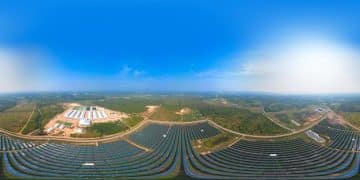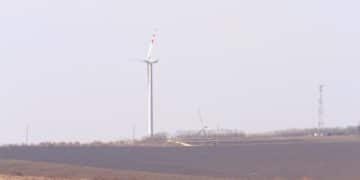Renewable Energy and the Grid: Shaping a Sustainable Future

Renewable energy integration into the grid is reshaping the future by enhancing sustainability, energy independence, and grid resilience, presenting both opportunities and challenges for the energy sector.
The integration of renewable energy and the grid: How integration is shaping the future, is rapidly transforming the energy landscape, offering pathways to a sustainable and resilient power system.
Understanding Renewable Energy Integration
Renewable energy sources like solar, wind, and hydro are becoming increasingly vital components of our energy mix. However, effectively integrating these resources into the existing power grid presents unique challenges and opportunities.
What is Grid Integration?
Grid integration refers to the process of connecting renewable energy sources to the electrical grid, ensuring a reliable and stable supply of electricity.
Challenges of Renewable Energy Integration
Integrating renewable energy sources is not without its challenges.
- Intermittency: Solar and wind power depend on weather conditions, leading to fluctuations in energy supply.
- Grid Stability: Maintaining a stable grid requires balancing supply and demand in real-time, which can be difficult with variable renewable energy sources.
- Infrastructure Limitations: Existing grid infrastructure may not be adequate to handle the influx of renewable energy, particularly in remote areas.

Overcoming these challenges requires innovative solutions, including investments in grid infrastructure, energy storage technologies, and advanced forecasting methods.
Benefits of Renewable Energy Integration
Despite the challenges, the benefits of integrating renewable energy into the grid are substantial, offering a cleaner, more sustainable, and resilient energy future.
Environmental Advantages
Renewable energy sources produce little to no greenhouse gas emissions, helping to mitigate climate change and improve air quality.
Economic Opportunities
The renewable energy sector is creating new jobs and driving economic growth, particularly in manufacturing, installation, and maintenance.
- Job Creation: The renewable energy industry employs millions of people worldwide.
- Reduced Energy Costs: Renewable energy can reduce reliance on fossil fuels, leading to more stable and predictable energy prices.
- Energy Independence: By harnessing domestic renewable resources, countries can reduce their dependence on foreign energy sources.
These economic benefits are driving increased investment in renewable energy projects and supporting the transition to a low-carbon economy.
Technologies Enabling Grid Integration
Several technologies are playing a crucial role in enabling the effective integration of renewable energy into the grid, addressing the challenges of intermittency and grid stability.
Energy Storage Solutions
Energy storage technologies, such as batteries and pumped hydro, can store excess renewable energy and release it when demand is high, helping to balance supply and demand.
Smart Grid Technologies
Smart grid technologies, including advanced sensors, communication networks, and control systems, enhance grid monitoring and management, enabling better coordination of renewable energy sources.
Smart grid technologies improve grid efficiency and reliability, reducing transmission losses. They also allow for bidirectional energy flow, accommodating distributed generation from sources like rooftop solar panels.
Advanced Forecasting Methods
Accurate weather forecasting and advanced modeling techniques can help predict renewable energy output, enabling grid operators to better manage fluctuations in supply.
Policy and Regulatory Frameworks
Supportive policies and regulatory frameworks are essential for promoting the integration of renewable energy into the grid, providing incentives for investment and ensuring fair competition.

Incentives and Subsidies
Government incentives, such as tax credits, feed-in tariffs, and renewable energy certificates, can help reduce the cost of renewable energy projects and encourage investment.
These financial incentives make renewable energy more competitive with traditional fossil fuels, accelerating the deployment of renewable energy technologies.
Grid Access Regulations
Clear and transparent grid access regulations are needed to ensure that renewable energy generators can connect to the grid in a timely and cost-effective manner.
- Net Metering: Allows customers with solar panels to receive credit for excess electricity they send back to the grid.
- Interconnection Standards: Ensures that renewable energy systems can safely and reliably connect to the grid.
These regulations create a level playing field for renewable energy developers, facilitating the integration of renewable energy into the grid.
Case Studies: Successful Grid Integration Projects
Several countries and regions have successfully implemented grid integration projects, demonstrating the feasibility and benefits of integrating renewable energy into the power system.
Germany’s Energiewende
Germany’s Energiewende, or energy transition, aims to phase out nuclear power and fossil fuels in favor of renewable energy sources. The country has made significant progress in integrating wind and solar power into its grid.
California’s Renewable Energy Mandates
California has implemented ambitious renewable energy mandates, requiring utilities to obtain a certain percentage of their electricity from renewable sources. The state has successfully integrated large amounts of solar and wind power into its grid.
These case studies provide valuable lessons for other countries and regions seeking to integrate renewable energy into their power systems.
Denmark’s Wind Power Integration
Denmark is a global leader in wind power integration, with wind energy accounting for a significant portion of its electricity supply. The country has invested heavily in grid infrastructure and smart grid technologies to manage the variability of wind power.
Future Trends in Renewable Energy Integration
The future of renewable energy integration is likely to be shaped by several key trends, including technological advancements, policy developments, and changing consumer preferences.
Increased Deployment of Energy Storage
As energy storage technologies become more affordable and efficient, they are likely to play an increasingly important role in enabling the integration of renewable energy into the grid.
Greater Use of Artificial Intelligence
Artificial intelligence (AI) and machine learning (ML) can be used to improve grid management, optimize energy consumption, and forecast renewable energy output, enhancing grid stability and reliability.
| Key Point | Brief Description |
|---|---|
| ⚡ Grid Integration | Connecting renewable sources to the grid for reliable electricity. |
| 🌱 Environmental Benefits | Reducing greenhouse emissions and improving air quality. |
| 💡 Smart Grid | Enhancing grid monitoring and management for better coordination. |
| 💰 Economic Growth | Creating jobs and reducing energy costs through renewable sources. |
FAQ
▼
The primary challenges include the intermittency of renewable sources like solar and wind, the need for grid stability, and infrastructure limitations such as inadequate transmission capacity. These factors require advanced technologies and strategies to manage effectively.
▼
Energy storage solutions, such as batteries and pumped hydro, store excess renewable energy generated during periods of high production and release it when demand is high, helping to balance supply and demand and ensure grid stability.
▼
Smart grid technologies, including advanced sensors, communication networks, and control systems, enhance grid monitoring and management. This enables better coordination of renewable energy sources, improving grid efficiency and reliability.
▼
Supportive policies include government incentives like tax credits and feed-in tariffs, along with grid access regulations that ensure renewable energy generators can connect to the grid efficiently. These measures encourage investment and fair competition.
▼
Examples include Germany’s Energiewende, California’s renewable energy mandates, and Denmark’s wind power integration. These projects demonstrate the feasibility and benefits of integrating renewable energy into the power system through policy and technology.
Conclusion
The integration of renewable energy and the grid: How integration is shaping the future, is essential for building a sustainable energy future. By addressing the challenges and leveraging the benefits of renewable energy, we can create a cleaner, more resilient, and economically vibrant energy system for generations to come.





